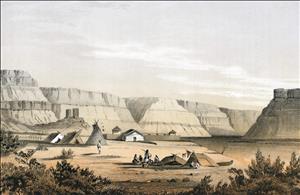In 1859, Roman Catholic Priest Toussaint Mesplie begins St. Patrick's Church. The church is the first in the small village of Steptoeville -- soon to be named Walla Walla -- and operates out of a structure consisting of "poles stuck in the ground and covered with shakes" (Lyman, 113). In this structure, with no floor and one bench, the first Mass is offered and Walla Walla County's first election is held. The church of St. Patrick's will relocate to new buildings in 1863, 1865, and 1881, and other Catholic institutions will grow alongside it. The last church building, a Gothic brick building, will serve the parish throughout the twentieth century and into the twenty-first.
From Diocese to Silence
The Diocese of Walla Walla, a territory extending between the Cascade and Rocky mountains and the borders of Canada and California, was established in 1846 and suppressed in 1853. Augustin Magliore Alexander Blanchet (1797-1887), who was appointed Bishop of Walla Walla in 1846, arrived at the Hudson’s Bay Company’s Fort Walla Walla in September 1847. A few months later, after the Whitman massacre, he relocated to the The Dalles, where he waited for an opportunity to return to the Walla Walla Valley. In 1850, Blanchet was transferred to the new Diocese of Nisqually.
During Blanchet’s brief tenure as bishop, two Catholic missions were established: St. Rose’s, at the confluence on the Columbia and Yakima rivers, and St. Anne’s, along the Umatilla River and about 25 miles south of the Protestant mission of Marcus (1802-1847) and Narcissa Whitman (1808-1847). During the Indian Wars of the 1850s, both Protestant and Catholic missionary activities were interrupted and St. Anne’s was abandoned. In 1852, Blanchet’s older brother, regional Archbishop Francis Norbert Blanchet (1795-1883), asked Eugene Casimir Chirouse (1821-1892) of St. Rose’s Mission to reestablish St. Anne’s. He did and established another mission named St. Rose near the former Whitman mission, but activities were suspended again and between 1856 and 1859 none are recorded at either mission.
From Wood to Brick
When Walla Walla County’s first election was held in July 1859, it took place in “The Church at Steptoeville” (Lyman, 113), a small village that was emerging around the United States military Fort Walla Walla, after which the town would soon take its name. Earlier in 1859, after the conclusion of the wars and treaty negotiations of the 1850s, the Roman Catholic Priest Toussaint Mesplie, who was stationed at The Dalles, started St. Patrick’s Church. This church consisted of poles covered with shakes; it had no floor and one bench. Mesplie is said to have offered the first Mass in the settlement to a small group of soldiers and white and Indian women. By the end of the year, St. Patrick’s consisted of 75 adults and 54 children.
During the 1860s, St. Patrick’s grew with Walla Walla. A new building for St. Patrick’s was consecrated in 1863; a school, St. Vincent’s Academy, was started in 1864; and another larger church building was completed in 1865. By 1870, planning began for an even larger building, a Gothic brick church that was dedicated on Christmas Day in 1881. Also during the 1870s, St. Patrick’s received its first resident pastor (1872) and St. Mary’s Hospital, which had originated within St. Vincent’s, was established (1879). All of these institutions continued to grow through the late nineteenth and early twentieth centuries. St. Patrick’s, a comprehensive parochial school system, and St. Mary’s (now Providence St. Mary Medical Center) continue as Catholic institutions in Walla Walla.

